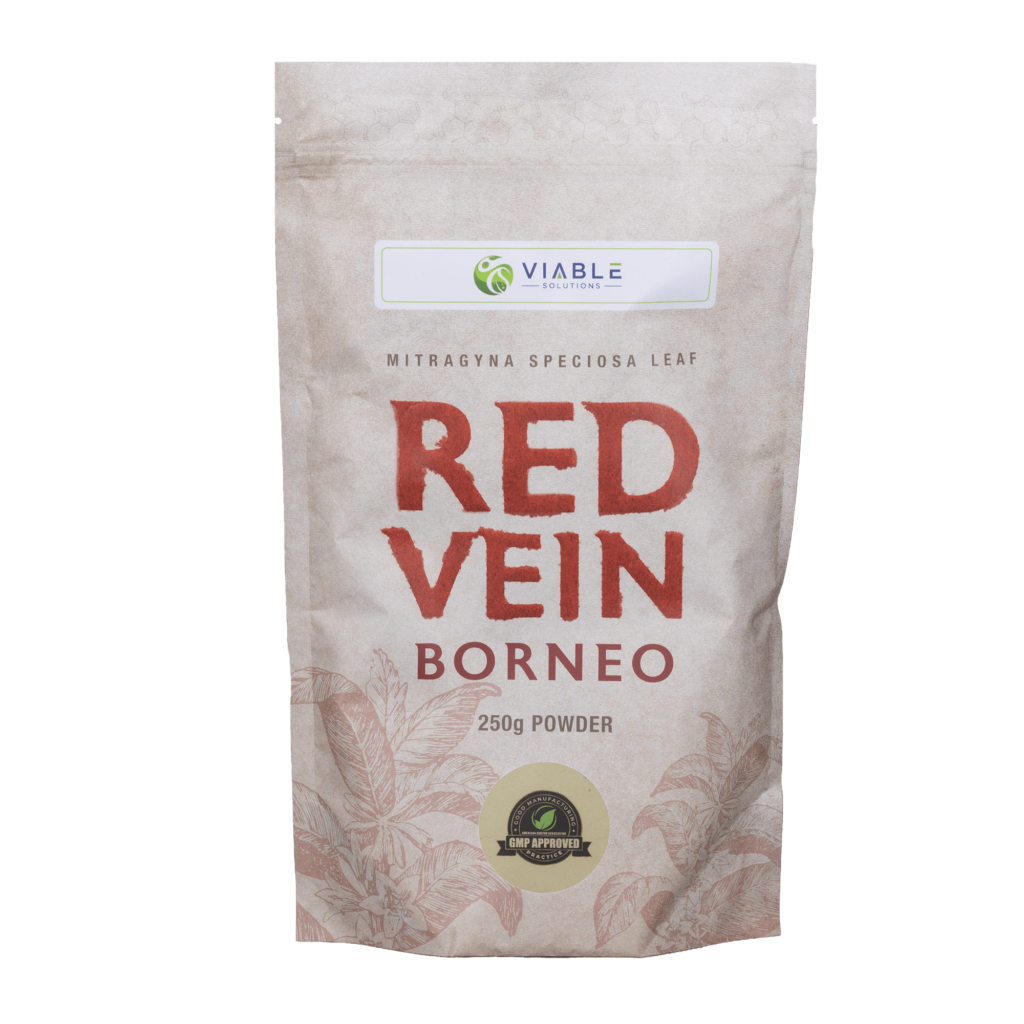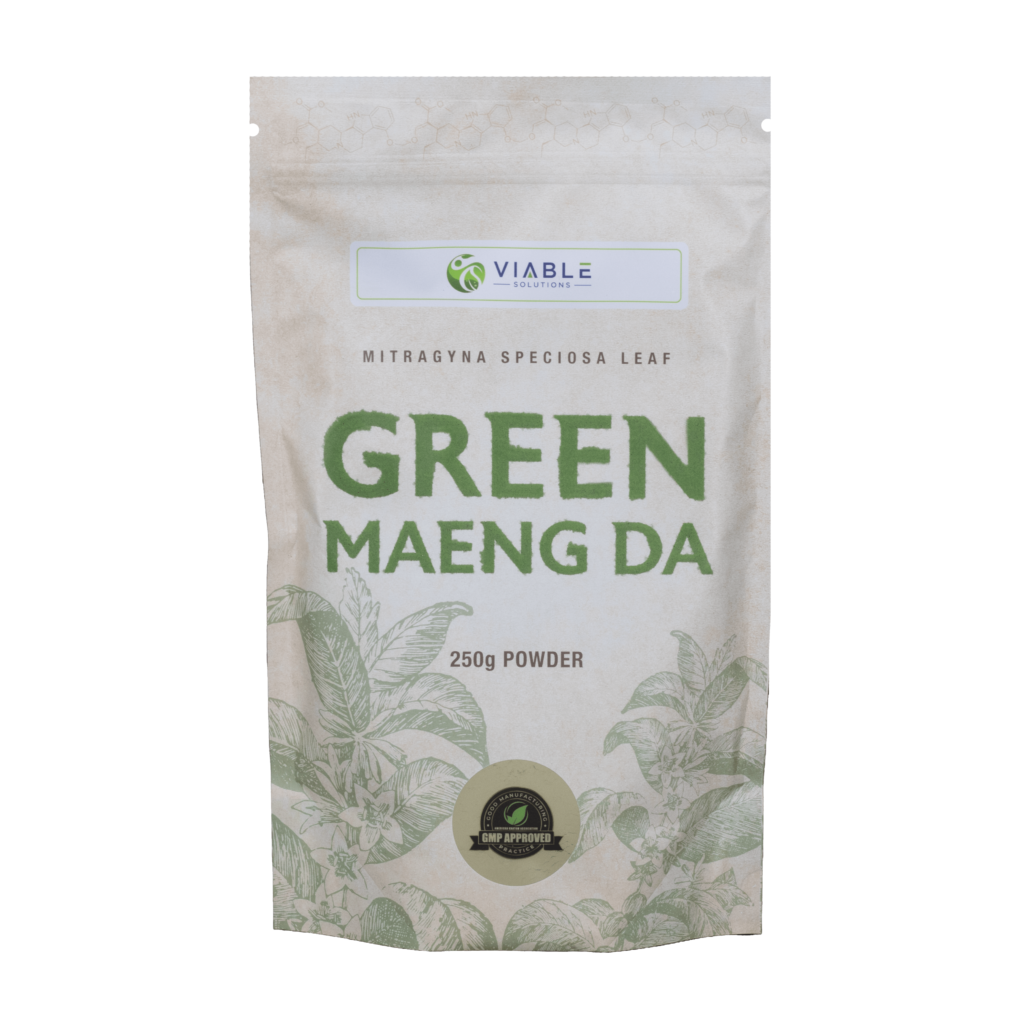When searching for natural alternatives to conventional pain management, kratom is a great choice for many.
This tropical tree, native to Southeast Asia, carries not just generations of traditional medicine but also the testimonies of countless individuals seeking relief in its leaves.
In this article, we’ll look at the best types of kratom for pain management.
(Disclaimer: Remember, we are not doctors! This is based on user experience, customer testimonials, and current research. Always consult with your doctor if you are unsure.)
Understanding Kratom and Its Pain-Relieving Properties
Kratom, or Mitragyna speciosa, is more than just a plant; it’s a centuries-old companion to human resilience against discomfort.
Central to kratom’s allure are its active alkaloids, primarily mitragynine and 7-hydroxymitragynine, which engage the body’s mu-opioid receptors, much like certain prescription medications, yet with a distinct profile.
Unlike the narrow path of opioids, kratom offers a broader spectrum of effects, from energizing to sedative, dictated by its strain, dosage, and your biology.
The pain-relieving prowess of kratom lies in its ability to interact with our pain perception pathways.
If you are wrestling with chronic pain, neuropathic pain, or the sharp sting of nociceptive pain, kratom presents a potential natural alternative.
When discussing the best kratom strains for pain realiving properties, the Red Vein strains, in particular, are renowned for their potent analgesic effects, making them a popular choice among the kratom community for pain management.
Maeng Da kratom, with its robust alkaloid profile, stands out for its dual ability to alleviate pain and enhance energy, offering a balanced approach to pain relief and daily activity.
But how does kratom achieve these effects?
The science points to the alkaloids’ action on the brain’s opioid receptors, which play a crucial role in pain modulation.
By mimicking the action of endogenous opioids, kratom alkaloids can potentially dull the body’s pain signals, offering relief without the high risk of dependency associated with conventional opioids.
Bali kratom, another favored strain, epitomizes this balance, offering pain relief with a side of mild euphoria, thus addressing both physical discomfort and the mental anguish that often accompanies it.
The journey with kratom is personal and varied. In the next sections, we’ll explore how to navigate this journey, aiming to ensure a safe starting point for beginners and deeper guidance for intermediate kratom users.

How Kratom Can Help With Pain
Pain, in its myriad forms, affects millions worldwide, acting as an unwelcome constant.
It manifests in various types, primarily categorized as chronic or acute, and further differentiated by its source: neuropathic or nociceptive.
Understanding these distinctions helps us in navigating the potential relief kratom can offer, as not all pain is created equal, nor is every strain of kratom suited to every kind of discomfort.
Chronic vs. Acute Pain
Chronic pain, a persistent thorn in one’s side, lingers well beyond the expected period of healing, often without a clear cause.
Acute pain, however, is a sharp, sudden response to injury or illness, acting as a distress signal.
Kratom’s diverse alkaloid profile makes it a unique tool in the pain management toolbox, capable of addressing both the enduring aches of chronic conditions and the sharp bite of acute incidents.
For chronic pain sufferers, strains with a high concentration of 7-hydroxymitragynine, such as Red Vein Bali or Red Vein Borneo, offer a soothing, long-lasting analgesic effect.
Conversely, for acute pain, where immediate relief is wanted, the more stimulating strains like Green Maeng Da can provide a quick onset of pain relief coupled with a mild energy boost to combat fatigue often associated with recovery.
Neuropathic vs. Nociceptive Pain
Neuropathic pain, a complex condition arising from nerve damage, presents a significant challenge to treat, often described as a burning or tingling sensation.
Nociceptive pain, rooted in tissue damage (be it from injury, arthritis, or other inflammations), is characterized by a sharp or aching sensation.
The multifaceted nature of kratom, particularly its interaction with opioid receptors, means it can potentially soothe neuropathic discomfort by mitigating the aberrant pain signals sent to the brain.
Strains rich in mitragynine, such as Maeng Da, are reputed for their ability to address this type of pain, offering both analgesic properties and mood-enhancing effects, which can be beneficial in managing the psychological impact of chronic neuropathic pain.
For nociceptive pain, the sedative qualities of Red Vein strains can help dull the acute sensations of tissue damage, promoting relaxation and aiding in the body’s healing process.
Choosing Your Kratom Strain for Natural Pain Management
Selecting the right kratom strain is paramount in effectively managing pain.
In the next section, we’ll look at our top recommended kratom strains
Each strain possesses a unique alkaloid composition, influencing its efficacy in treating different pain types.
Understanding the nuances of each strain’s effects allows individuals to tailor their kratom use to their specific pain management needs.
The Best Kratom Strains for Pain Relief

Among the plethora of kratom strains available, certain varieties have garnered acclaim for their potent analgesic properties and their ability to significantly improve pain management.
Here are some of our favorite kratom strains and products for pain relief.
Red Vein Kratom for Pain
Red Vein Kratom is highly sought after for its potent analgesic properties, making it the preferred choice for individuals suffering from chronic pain.
Characterized by its high levels of 7-hydroxymitragynine, this strain offers profound relief from pain, coupled with a deep sense of relaxation and calm.
Its effects on chronic pain are notable, providing a soothing experience that helps mitigate the discomfort associated with conditions like arthritis, fibromyalgia, and chronic back pain.
The preference for Red Vein Kratom in pain management stems from its ability to deliver substantial pain relief without the intense stimulation that other strains might induce.
This makes it ideal for evening or nighttime use, helping users relax and achieve restorative sleep, which is crucial for the body’s healing processes.
Our Favorite Red Vein Kratom Product:

Maeng Da Kratom for Pain
Maeng Da Kratom is renowned for its high potency and is believed to originate from selective breeding practices in Thailand.
This strain stands out for its dual ability to alleviate pain and boost energy levels, making it suitable if you’re seeking pain relief while maintaining an active lifestyle.
Maeng Da’s balanced profile assists in managing pain without leading to drowsiness or lethargy during the day.
Its suitability for both pain relief and energy comes from its unique alkaloid profile, which includes a higher concentration of mitragynine.
This compound not only helps in dulling the perception of pain but also provides a gentle energy boost, enhancing focus and productivity.
Our Favorite Maeng Da Kratom Product:

Bali Kratom for Pain
Bali Kratom is celebrated for its fine balance between offering pain relief and producing sedative effects.
This strain provides a versatile choice if you need pain relief but also seek a slight sedative effect to help with anxiety or insomnia associated with pain.
Its balanced effects make it a popular option for beginner kratom users or anyone looking for a mild, all-around strain for pain management.
The versatility of Bali Kratom comes from its moderate alkaloid content, which ensures pain relief without overly sedating effects.
This makes it an excellent choice for daytime use, allowing users to manage pain while engaging in daily activities.
How to Choose and Use Kratom for Pain
Navigating through the kratom strains for pain relief can be daunting, but with the right guidance, you can make informed decisions that enhance your quality of life.
The key to utilizing kratom effectively lies in selecting the appropriate strain, dosing carefully, and choosing quality sources.
Your specific type of pain dictates the strain that may be most beneficial.
For chronic and neuropathic pain, Red Vein strains are often recommended for their potent analgesic effects and ability to promote relaxation.
If you want pain relief but also need to maintain energy and focus, Maeng Da or Green Vein strains could be more suitable.
Experimenting under controlled conditions can also help you find the strain that best addresses your pain while aligning with your lifestyle needs.
If you are a beginner kratom user, start with a low dose, typically between 1-2 grams, and gradually increase it until you find the minimum effective dose for pain relief.
This cautious approach helps mitigate the risk of side effects and builds an understanding of how your body responds to kratom.
Plus, the quality and safety of kratom is crucial to your experience.
We recommend shopping for your kratom from Viable or Motark.
Potential Risks and Side Effects
While kratom can offer significant pain relief, it’s important to be aware of its potential risks and side effects.
Responsible use and an awareness of the signs of overuse are crucial in minimizing risks.
Kratom’s side effects may include nausea, dizziness, dry mouth, constipation, and in some cases, sedation. These effects are typically dose-dependent, with higher doses increasing the likelihood of experiencing them.
Listening to your body and taking regular breaks from kratom can help prevent tolerance and dependence.
Conclusion
As we wrap up our exploration into kratom’s world and its knack for tackling pain, let’s recap.
Kratom has shown us there’s a natural, alternative pathway to managing pain—one that’s both old and new.
We’ve taken a closer look at the stars of the natural pain management show: Red Vein, Maeng Da, and Bali kratom.
Each one, with its unique charm, caters to different shades of pain, be it the deep, nagging ache that just won’t quit, or the need for a gentle nudge of energy while soothing discomfort.
It’s pretty clear that finding the ‘best’ kratom isn’t a one-size-fits-all deal—it’s a personal choice, much like picking your favorite coffee blend.
But, hey, diving into kratom isn’t just about picking the right strain. It’s also about smart, safe use. Starting small, knowing where your kratom comes from, and staying tuned in to how it affects you are your keys to a good experience.
Remember: this journey is as unique as you.
Whether you’re leaning towards the soothing embrace of Red Vein, the balanced boost of Maeng Da, or the gentle touch of Bali, kratom offers a path to pain management that’s worth exploring—with curiosity, caution, and a spirit of discovery.
Frequently Asked Questions about the Best Kratom for Pain

Q: Can kratom really help with pain management?
A: Yes, many users report that certain strains of kratom can help manage pain. The active compounds in kratom, such as mitragynine and 7-hydroxymitragynine, interact with opioid receptors in the brain, potentially reducing the perception of pain. Research is ongoing to fully understand its efficacy and safety.
Q: What types of pain can kratom help alleviate?
A: Kratom may help with various types of pain, including chronic pain, neuropathic pain, and nociceptive pain. Users have found it helpful for conditions like arthritis, back pain, fibromyalgia, and post-operative recovery. However, effectiveness can vary based on the strain and individual biology.
Q: Which kratom strain is the best for pain relief?
A: Red vein strains are often recommended for pain relief due to their potent analgesic properties and calming effects. Specifically, Red Vein Bali, Red Vein Maeng Da, and Red Vein Borneo are among the most cited for their effectiveness in managing pain.
Q: Which kratom strain is the best for pain relief?
A: Dosage can vary widely depending on the individual’s tolerance, the strain, and the severity of pain. It’s generally advised to start with a low dose (1-2 grams) and gradually increase until you achieve the desired effect. Consulting with a healthcare provider is recommended to discuss appropriate dosages.
Q: Are there any side effects of using kratom for pain?
A: While kratom can offer pain relief for many, it can also cause side effects, especially at higher doses. Common side effects include nausea, dizziness, dry mouth, constipation, and sleep issues. Long-term use can lead to dependence and withdrawal symptoms.
Q: Can I use kratom with other medications?
A: Kratom can interact with other medications, potentially leading to adverse effects. If you’re considering using kratom for pain management and are currently on medication, it’s crucial to consult with a healthcare provider to discuss potential interactions and risks.


Leave a Reply